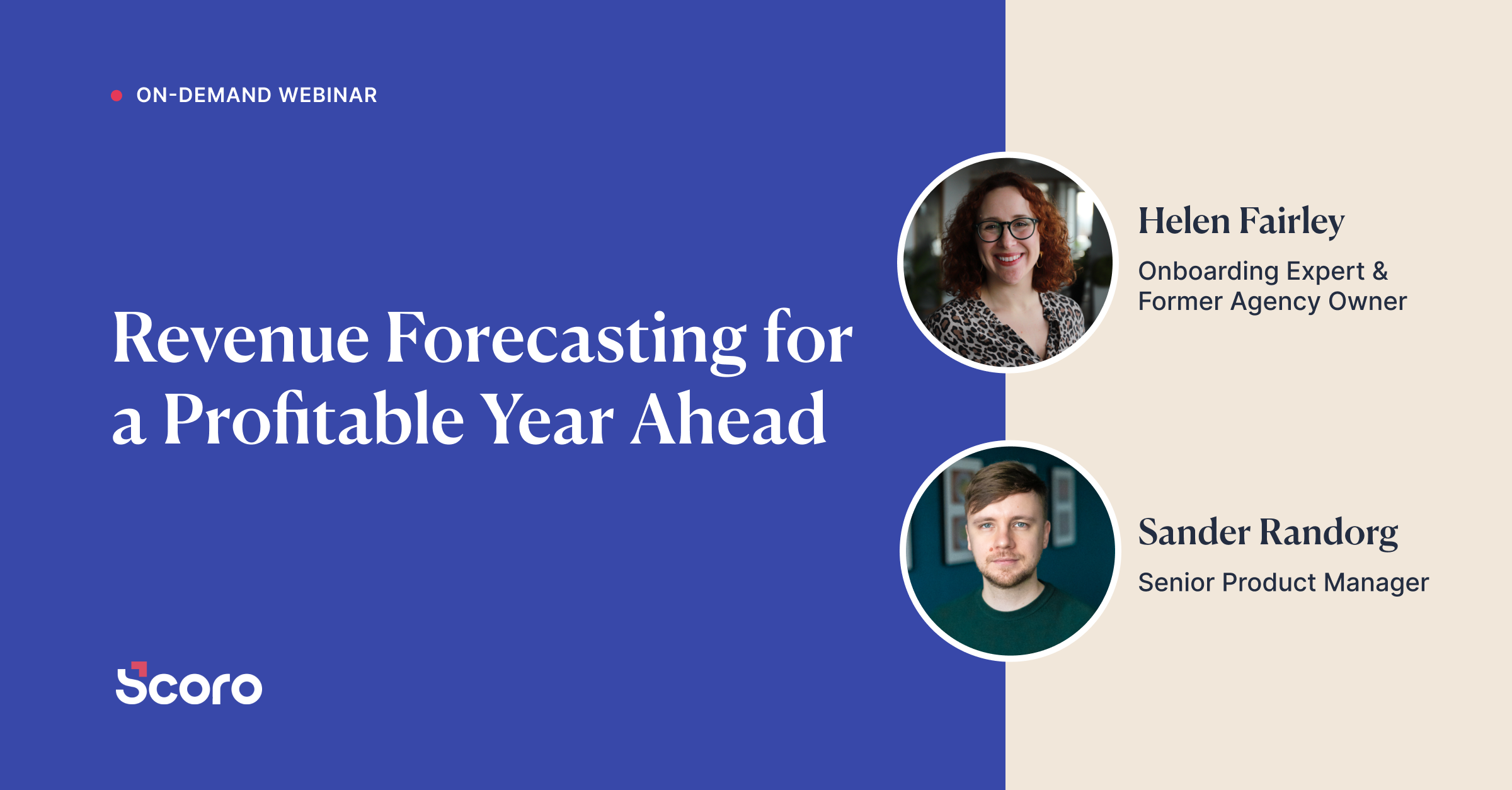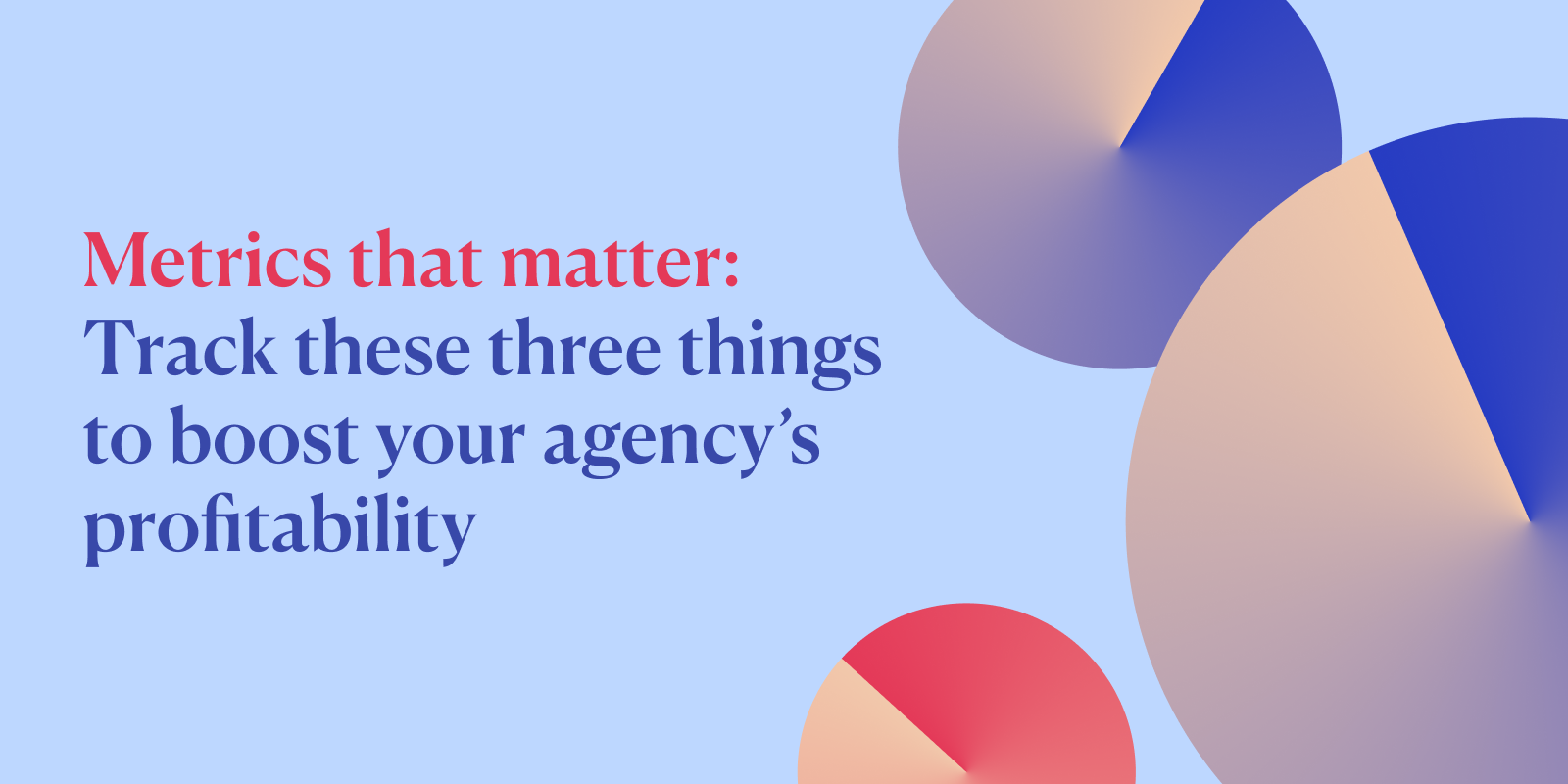Metrics that matter – with Marcel Petitpas
The following blog is a condensed version of a recent webinar we hosted in partnership with Marcel Petitpas, CEO and Founder of Parakeeto, who has helped scores of high growth creative agencies, consultancies and service businesses track the right metrics and maximize their profitability. When you’ve read the blog, why not watch the recording of the webinar to gain even more insight into this fascinating topic?
In today’s fast-paced and complex business landscape, agencies face numerous challenges when it comes to measuring and improving their profitability. The traditional approach of relying solely on financial data to gauge performance is no longer sufficient. As the industry has evolved over the past few decades, the pressure on margins has increased, service businesses have become more intricate, and smaller firms now operate with complex business models.
Gone are the days when agencies solely billed by the hour. Today, they grapple with various pricing models, such as flat rate pricing, retainers, and value-based pricing, each bringing its own set of challenges and risks. Furthermore, the talent market has transformed, adding another layer of complexity to agency operations. In this ever-changing landscape, it is crucial to rethink how we measure agency performance beyond just financials.
While financial data is essential for legal compliance and tax purposes, it often falls short in providing timely and valuable insights for making strategic decisions.
The heavy reliance on financial reporting systems constrains the pace of insight across other areas of the business, leaving agencies blind to critical information until it’s too late. To overcome this challenge, it is vital to create a healthy separation between financial reporting systems and operational reporting systems, enabling agencies to gain real-time insights into their operations.
In this blog post, we will explore three key metrics that matter for agencies, focusing on data beyond financials. By decoupling the ability to gain valuable insights from slow and retroactive financial data, agencies can transform their decision-making processes and gain a competitive edge. We’ll discuss simple and practical ways to measure these crucial metrics and empower agencies to make informed strategic choices.
Get ready to discover the metrics that truly matter and take your agency’s performance to new heights.
Three Challenges When Considering Metrics
First off, let’s take a look at the challenges you may face in tracking metrics.
1. Lack of Clarity and Strategy
One of the major challenges agencies face when it comes to measuring their performance is the absence of a clear vision or strategy. If you find yourself solely focused on financial information such as profit and loss statements or balance sheets provided by your accountant or finance department, it’s time to reassess your approach. Measuring individual project performance, conducting departmental analysis, evaluating service types, utilization rates, and forecasting should not feel cumbersome or unclear. In this section, we will address strategies to close these gaps and establish a robust framework for measuring agency performance beyond financial data.
2. Messy Data
Data management can become a significant roadblock when attempting to measure and analyze agency metrics. Messy data can hinder your ability to gain accurate insights. For instance, comparing actual time spent on a project with the estimated time may prove challenging if entries in your timesheets don’t align with the project estimates due to inconsistent naming conventions or formatting. The time-consuming task of cleaning up data to obtain the desired answers can be frustrating. We will explore ways to streamline data management and ensure your metrics are based on reliable and consistent data sources.
3. Guesswork and Stress
The absence of clear and accessible information can lead to guesswork and stress when making critical decisions for your agency. Hiring or firing team members, taking on new projects, or determining project start dates all require data-driven decision-making. However, timely access to relevant data is often lacking. If you find yourself guessing and stressing about important business decisions, it’s time to address this issue. We will discuss methods to improve data availability and empower you and your team to make informed choices based on reliable metrics.
Our aim is to provide you with clear metrics, benchmarks, and frameworks that can be easily measured and implemented within your agency. We will guide you towards repeatable outcomes, creating alignment and predictability for your team. Our focus is on empowering your team with data without the need for full open book management, eliminating the risk associated with exposing sensitive financial information. Together, we will overcome the challenges of coupling operations reporting with finance and find a simpler approach to leverage data effectively.
Here’s what you should measure
Measure Agency Gross Income
Let’s delve into the core financials, despite my earlier reservations about them. The reality is that financials remain the go-to source of truth when it comes to understanding past performance. Every agency is already familiar with and investing resources into financial statements. In this section, I want to shed light on what insights you should be able to extract easily from your financials and what objectives you should strive for.
First and foremost, your monthly profit and loss statement should allow you to track your revenue. Knowing how much money flows into your agency is essential for identifying any issues or areas that need improvement. However, it’s crucial to go beyond revenue and isolate a specific metric called Agency Gross Income (AGI).
So, what sets AGI apart from revenue? AGI requires us to isolate what we call “pass-through expenses.” These expenses refer to costs that pass through your agency to external vendors, for which you are not responsible for profitability. Examples include advertising spend, print budgets, white-label partnerships, and outsourced vendors for specific projects. By subtracting pass-through expenses from revenue, we obtain AGI—a more accurate representation of the money that your agency is accountable for earning with its time and resources.
On your profit and loss statement, you may find pass-through expenses listed under the Cost of Goods Sold (COGS) section. It’s important to note that the line indicating “gross profit” on your P&L is not actually your gross profit. Rather, it reflects your agency’s gross income. Understanding the distinction allows you to gauge your agency’s profitability and efficiency accurately.
Next, we need to focus on understanding delivery profit, which aligns with gross profit on services rendered. Delivery profit represents the cost incurred to complete the work for which your agency was compensated—a measure of the promise fulfilled to your clients. To calculate delivery profit, you must isolate delivery costs, primarily consisting of payroll allocated to team members responsible for client work. This includes designers, copywriters, developers, project managers, and others directly involved in client services. Additionally, you should factor in shared delivery expenses, such as software subscriptions and licenses, necessary tools for your team’s work. The goal is to keep delivery costs below 50% of agency gross income, enabling you to maintain a delivery margin of 50% or higher.
While financials often focus on revenue and delivery profit, it is crucial to consider overhead expenses as well. Overhead can be broken down into three subcategories: administration, sales and marketing, and facilities (if applicable). The key is to keep total overhead within the range of 20% to 30% of agency gross income. This ensures a healthy profit margin of 20% to 30% remaining after accounting for overhead expenses.
Now, here’s a significant insight that often goes unnoticed. Many struggling agency owners tend to focus on cutting overhead costs in their quest for profitability. However, the real leverage lies in improving delivery profit. Increasing agency gross income and optimizing the relationship between client revenue and delivery costs is the foundation for a profitable agency.
By enhancing delivery profit and achieving a delivery margin of 50% or higher, you’ll notice a positive impact on overhead costs as a proportion of income.
In summary, while financials can be complex, measuring agency gross income and delivery profit is crucial. These metrics offer invaluable insights into the relationship between client revenue, delivery costs, and overall profitability. By improving delivery profit and maintaining a healthy delivery margin, you set your agency on a path to sustainable success.
Measure Average Billable Rate
Let’s discuss average billable rate—a crucial metric that provides insights into how much your agency earns for every hour your team spends on client projects. Understanding and optimizing average billable rate allows you to make more efficient use of your team’s time and increase revenue.
The formula for calculating average billable rate is straightforward. It involves dividing your agency gross income by delivery hours. It’s important to note that we use the term “delivery hours” rather than “billable hours” to emphasize that we base this calculation on the actual time it took to complete the work, regardless of what was billed to the client.
Average billable rate can be measured for various subsections of your agency, whether it’s a week, month, quarter, year, or even for specific clients, projects, departments, or the entire agency. By isolating two simple inputs—how much money you earn and how much time you spend—you can gain valuable insights into revenue efficiency across different areas of your business.
To improve the relationship between your average billable rate and delivery costs, there are three main approaches:
- Focus on Average Cost per Hour: Average cost per hour serves as a leading indicator and proxy for delivery costs. This metric measures how much labor costs on a per-unit basis. By evaluating average cost per hour, you gain insights into the cost-effectiveness of your team’s work. Decreasing average cost per hour allows you to allocate more work to less expensive team members, reducing overall delivery costs. This can be achieved by streamlining processes, leveraging technology, using templates, and providing comprehensive guides to minimize the need for judgment calls, enabling more junior employees to handle tasks. Ultimately, decreasing delivery costs positively impacts your profitability.
- Optimize Average Billable Rate: Average billable rate focuses on how much revenue is generated for each hour your team spends on client projects. By increasing your average billable rate, you boost revenue and profitability. It’s essential to evaluate the average billable rate regularly and identify areas where efficiency can be improved. Analyzing projects or clients with higher or lower average billable rates allows you to extract insights and apply best practices to other areas of your business. This metric becomes a catalyst for conversations and strategies aimed at maximizing revenue and productivity.
- Estimate Delivery Margin: The formula for delivery margin—agency gross income minus delivery cost, divided by agency gross income—can be approximated using average cost per hour and average billable rate. While not as precise as calculating delivery margin directly, this estimation provides a cost-effective and quick way to gauge the efficiency of different areas within your agency and identify opportunities for improvement.
Consider running regular reports to track average billable rate across various projects or clients. This data-driven approach allows you to identify areas of high efficiency and uncover insights that can be applied to other projects. By leveraging average billable rate as a performance indicator, you can have focused conversations with your team, identify process improvements, and optimize revenue generation.
Remember, average billable rate is a valuable metric that helps you understand revenue efficiency and profitability. By aligning your efforts with the three approaches outlined above, you can maximize the value your agency delivers to clients while increasing your bottom line.
Measure Utilization Rate
The final lever we’ll discuss is the utilization rate, a metric that can significantly impact your agency’s revenue generation. Utilization measures the extent to which your team’s capacity is utilized for revenue-generating activities. It is a powerful metric but must be used responsibly to avoid negative consequences for your agency and team.
Utilization is calculated by dividing the number of delivery hours worked during a specific period by the team’s capacity for that period. It measures the proportion of time spent on revenue-generating activities relative to the total available capacity. Utilization provides insights into how efficiently your team is using their time to move revenue from the balance sheet to the profit and loss statement.
There are two primary ways to address a gap in utilization:
- Sell More Work: To close the utilization gap, you can sell more work and increase the number of delivery hours. However, it’s crucial to sell work that generates additional revenue, rather than merely increasing the time spent on existing projects. Merely spending more time without increasing revenue will not improve profitability. Selling more work involves finding opportunities to bill clients for additional services, taking on new projects, or exploring expansion opportunities.
- Lower Capacity: The second option to close the utilization gap is to reduce capacity, which means laying off team members. This option should be a last resort and avoided whenever possible, as it can have negative consequences for your team and agency.
When measuring utilization, it’s essential to establish a baseline and benchmarks. The baseline utilization includes the capacity for both billable and non-billable team members. This approach ensures that the cost of non-billable time, such as paid time off and holidays, is reflected in the utilization calculation. It simplifies the metric and avoids the need for complex adjustments throughout the reporting system. Moreover, by factoring in the cost of time off and non-billable hours, you can set appropriate delivery margin targets that include those costs.
Utilization benchmarks vary depending on the roles within your agency:
- Pure Producers: These team members, such as developers or designers, typically have a weekly utilization target of 75% or higher. However, their utilization can be influenced by client dilution, which refers to the number of clients they work with simultaneously. High client dilution can lower their utilization rate, even if they are productive.
- Delivery Managers, Account Managers, and Project Managers: These roles usually have utilization targets above 35% as they focus more on managing the delivery team rather than directly working on client projects.
- Others: Administrative assistants, salespeople, and other team members typically have lower utilization targets. Any utilization above zero is considered a bonus for these roles.
As an agency, it’s generally desirable to have an agency-wide utilization baseline of 65% or higher.
However, the actual target may vary based on factors like unlimited time-off policies. When calculating utilization on an annual basis, it’s common to subtract 10% to 15% (or even up to 20% for generous time-off policies) to account for non-billable time, holidays, and vacations.
To illustrate the impact of utilization on profitability, consider a small agency with 10,000 hours of capacity and delivery costs of $300,000. In the first example, with a 50% utilization rate and an average billable rate of $100 per hour, they can generate $500,000 in agency gross income, resulting in a 40% delivery margin. By increasing utilization to 60% while keeping the average billable rate the same, they can generate $600,000, achieving a 50% delivery margin. Finally, with an average billable rate of $125 per hour, they earn $750,000 and increase their delivery margin to 60%. This improvement in delivery margin translates to a significant increase in net profitability, with an additional $250,000 straight to the bottom line.
Remember that optimizing average billable rate and utilization, even with seemingly small adjustments, can have a substantial impact on your agency’s profitability. By understanding and leveraging these metrics effectively, you can drive revenue growth and enhance your agency’s financial performance.
Marcel Petitpas is the CEO & Co-Founder of Parakeeto, a company that helps agencies improve their profitability. He spends most of his days elbow-deep in agency reporting, helping them make the correct decisions based on their data.


